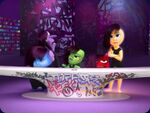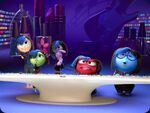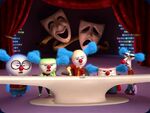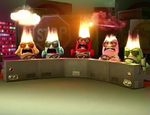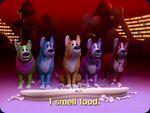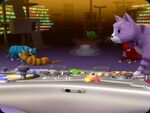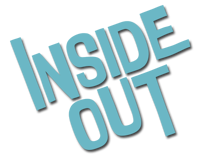The Emotions are the main characters of the Disney/Pixar Inside Out franchise. The Emotions (Joy, Sadness, Fear, Disgust, and Anger; Anxiety, Envy, Embarrassment, Ennui, and possibly Nostalgia starting in one's teenage years) are several different-colored humanoid creatures who are in charge of running the mind of the person, animal, or, occasionally object they inhabit. Almost all emotions are female, except Anger, Fear and Embarrassment, who are all male.
Formation and Leadership[]
Each Emotion is created at a different moment, usually early in someone's life. They seem to appear from nowhere.
Each person has a central Emotion that acts as the unofficial leader of the group. The central Emotion is usually positioned in the center of the group, and controls most of the person's actions. In Riley Andersen's mind, Joy is in charge, while her father's mind is controlled by Anger, and her mother's mind is run by Sadness.
The film suggests that the first Emotion to appear is the one who is in charge, as Joy appears first in Riley's mind.
Residence[]
The Emotions reside in the mind of each living entity, and they live and work in the Emotion Headquarters.
Appearance[]
The Emotions tend to take on the appearance of the person they reside in. For example, Mr. Andersen's Emotions all have a mustache and wear a suit like he does, and Mrs. Andersen's Emotions all have brown hair in a ponytail and wear red-framed glasses. Various other characters' Emotions resemble them in some form, like having dyed hair or multiple piercings. Riley is the only character to have Emotions that do not resemble her. This has been done to have her emotions be differentiated from the rest that are seen in the film and also due to her being the main focus.
The look of each emotion is also based on other things. Joy is based on a star and a burst of energy, Anger is based on a firebrick, Disgust is based on broccoli, Fear is based on a raw nerve, and Sadness as a teardrop. Of the new emotions, Anxiety is based on electricity, Envy is based on a mushroom, Ennui is based on a limp noodle, Embarrassment is based on a blush, and Nostalgia is based on a cute grandmother wrapped in blankets.
Each emotion has its own respective color, with Joy being yellow, Anger being red, Sadness being blue, Disgust being green, Fear being purple, Anxiety being orange, Envy being teal, Embarrassment being pink, Ennui being indigo, and Nostalgia being taupe. The emotions seem to be made of light particles, the outermost which cycle in luminescence.
Role[]
Each emotion has one specific role that helps their person in their daily life. No matter how small one emotion's role may be, all of them are important and necessary for the well-being of the person:
- Joy: enables the person to experience many positive and pleasurable feelings, such as excitement, amusement, gratification, satisfaction, optimism, etc. Her main purpose is to ensure the well-being and happiness of her person.
- Sadness: enables the person to experience many hurtful, painful feelings that could make one teary eyed, such as sorrow, grief, distress, remorse, disappointment, etc. Her main purpose is to relieve one's emotional pain, while also providing a distress signal to those around them and show empathy for others. May overlap with Anger.
- Fear: enables the person experience any and all primal feelings of fight-or-flight, such as wariness, apprehension, fright, terror, etc. His main purpose is to ensure one's safety and raise awareness of potential dangers. May overlap with Anxiety.
- Disgust: enables the person to experience any or all feelings of dislike, such as revolt, aversion, judgement, disdain, etc. Her main purpose is to ensure one is not "poisoned", being it physically or socially, in this way being critical about one's desires and shaping their taste.
- Anger: enables the person to experience any or all intense fiery feelings of irritation, annoyance, rage, resentment, indignation, hostility, aggression, etc. His main purpose is to ensure one's rights are taken in consideration when they are threatened, in this way keeping things "fair" for the individual. May overlap with Sadness.
- Anxiety: enables the person to experience any and all unpleasant feelings of tension, restlessness, worry, nervousness, guilt, etc. Her main purpose is to raise awareness to any potential scenario that may be prejudicial to one's well-being and eliciting one to diffuse and fix a mistake or problem or even before whichever one happens. May overlap with Fear.
- Envy: enables the person to experience and all feelings of desire towards anything or anyone they find interesting, such as covetousness, craving, yearning, aspiration, adoration, etc. Her main purpose is to let one know what they want and/or desire.
- Embarrassment: enables the person to feel any and all feelings of self-consciousness and feeling ashamed, such as discomfort, humiliation, mortification, modesty, etc. His main purpose is to suppress any undesirable and/or unacceptable behavior, keep one humble and to act as an appeasement gesture for said behavior.
- Ennui: enables the person to any and all feelings of apathy and or indifference towards anything or anyone, such as listlessness, disinterest, aloofness, etc. Her main purpose is to allow the person to stray away from high stress or unnecessary situations, and to "keep it cool" to hide their true feelings.
- Nostalgia: enables the person to experience any and all sentimental, longing, warm, and affectionate feelings for the past. Her main purpose is to allow one person to reminisce on past and significant experiences and, in this way, remember the warmth and happiness they have felt, reconnect with their values or see them in another perspective.
The emotions also manage the many aspects of one person's mind, like calling up memories and ideas, manage imagination, determine which secrets are kept inside the vault, dream duty... After a person starts to develop their sense of self, emotions get the addition duty of helping their person develop their sense of self (their individuality) by placing key memories on the pool of the Belief System (located at the basement of HQ, below the Memory Dump).
Media[]
Disney Heroes: Battle Mode[]

Original 5 Emotions in Disney Heroes: Battle Mode
The original 5 emotions appear in video game Disney Heroes: Battle Mode. Each of the emotions is associated with their unique passive buff which symbolizes their main role (emotion), this buff increases the effectiveness of their skills. Anger and Joy were introduced in 2019, while Sadness, Disgust, and Fear were added in 2020 during the 5th Anniversary of the first movie.
- Joy is a Support role hero. Her main role is to heal allies and increase their reality and Max HP. Her unique buff is "Happiness!". Joy has friendship campaigns with Olaf and Anger.
- Sadness is a Tank role hero. Her main role is to increase armor and reality on herself and her allies while also applying fatigue and silence to enemies. Her unique buff is "Sorrow". Sadness has friendship campaigns with Eeyore and Joy.
- Anger is a Damage role hero. His main role is to deal massive damage to enemies and support his allies by increasing their attack speed and basic damage stat. His unique buff is "Rage". Anger has friendship campaigns with Emperor Zurg and Hades.
- Disgust is a Control role hero. Her main role is to deal damage to enemies while also silencing them and stealing buffs from enemies. Her unique buff is "Distaste". Disgust has friendship campaigns with Flynn Rider and Sadness.
- Fear is a Support role hero. His main role is to increase armor on himself and allies, decrease critical damage taken, and shielding allies. His unique buff is "Dread". Fear has friendship campaigns with Rex and Anger.
Trivia[]
- While some people's Emotions are the same gender as they are (for example, all of Bill Andersen and Jordan's Emotions are male and all of Jill Andersen, Cool Girl, Bree, and Grace's Emotions are female), others have multiple genders to their emotions; for instance, while Riley's Joy, Sadness, Disgust, Anxiety, Envy, Ennui, and Nostalgia are female, her Fear, Anger, and Embarrassment are male.
- There are several occasions when the emotions are seen happy, frustrated, or sad, proving that emotions can express more feelings than their own representation. Despite this, their feelings and concerns are mostly tied down to who or what they are.
- Animals are shown to have the same five emotions as humans. However, unlike taking the appearance of shapes and people, the emotions take the form of the animal they inhabit.
- The emotions can feel the same things their host feels, such as smell, taste, pain, and temperature. This is the reason the Emotions hate broccoli and keep Riley away from it, and why Sadness knew that Riley squirting milk through her nose while laughing felt painful.
- In psychology, Paul Ekman made a model of emotion where he claims there are six classified emotions: anger, disgust, fear, happiness, sadness, and surprise. The emotion Surprise was cut because Pete Docter considered the emotion to be too similar to Fear.
- Each original emotion matches one of the Five Stages of Grief - Denial (Fear), Anger (Anger), Bargaining (Disgust), Depression (Sadness), and Acceptance (Joy).
- Notably for the Bus Driver, his emotions all represent Anger in different colors, possibly referring to the emotion overlaps: Righteousness, Betrayal, Rage, Hatred, Loathing.
- Some inanimate objects (such as Happy Meal boxes) have emotions.
- As the person ages, more emotions enter the mind. Anxiety, Embarrassment, Envy, and Ennui come after puberty starts. Anxiety mentions that Nostalgia wasn't supposed to come until a couple of years later, hinting that Riley could have a new wave of emotions later in life.
- This also ties back into the original concept of the first film, where there was a total of 27 emotions residing within Riley's mind (the ones that were shown in the second film were the one of many that were cut in the first) and resided in the back of Headquarters, only coming up when needed.
- The fact that Riley started with five emotions and later got more is a reflection of how the human mind is more complex and how a child's mind grows into that complexity as they start to enter adulthood. All the five initial emotions (Joy, Sadness, Anger, Fear and Disgust) are part of the basic emotions that are shared by all sentient beings (as seen how animals like dogs and cats have emotions as well). The emotions that arrive with puberty are more complex and are a reflection of humans' nature of wanting more than what they need and the rules imposed to them by society.
- Joy (peach) and Nostalgia (brown) are the only emotions who have human skin colors.
- All of the emotions have 5 fingers on each hand, except Envy, who has only 4 fingers on each hand.
- None of the emotions have visible ears, not even the most humanoid ones like Disgust or Joy.
- The emotions sleep, with them doing it while their person is sleeping and waking up when the person wakes up. This is representative of when a person wakes up and takes a few moments to be fully aware of their surroundings.
- Even if emotions normally sleep when their person sleeps, at least one of them remains awake to watch over their dreams, with them doing it in turns and their reactions to the dreams being possibly the reason why some of them are remembered and/or forgotten and why some of them are just cut-off.
- Emotions also can wake Riley up and/or prevent her from falling asleep. This is showed by how Fear has a tendency to wake Riley up whenever she has a bad dream when he gets dream duty and how Anxiety was able to keep Riley awake by projecting to her many anxious thoughts.
- The emotions are shown (at least the five original ones) to sleep on the same quarters on bunk beds (except for Anger) and each have a different way of sleeping:
- Joy sleeps on a bunk bed under Sadness' and she is seen sleeping in weird positions, while snoring and having occasional laughs.
- Sadness sleeps on a bunk bed over Joy's and she is seen sleeping in a comfy position and quietly.
- Anger sleeps on a bed by a bay window and he is seen grunting and punching air while sleeping.
- Fear sleeps on a bunk bed under Disgust's and he is seen sleeping while hugging a teddy bear and with night-lights.
- Disgust sleeps on a bunk bed over Fear's and she is seen sleeping with a sleeping cap and mask.
- It's unknown if the new emotions (Anxiety, Envy, Embarrassment and Ennui) have their own beds or if they sleep on the same quarters as the old ones, however, in the book Go to Sleep, Anxiety! is revealed a little of how they sleep as well.
- Anxiety has a lot of trouble in falling a sleep due to her worries.
- Envy sleeps with rolls on her hair, as she wants her hair to look as good as Disgust's.
- Embarrassment sleeps in a cozy sleeping bag that he zips up to the very top.
- Ennui sometimes prefers to be at her phone instead of going to sleep.
- Even if emotions normally sleep when their person sleeps, at least one of them remains awake to watch over their dreams, with them doing it in turns and their reactions to the dreams being possibly the reason why some of them are remembered and/or forgotten and why some of them are just cut-off.
- Despite appearing that the emotions have full control over their person, the reality is that they only serve as guides/managers of the mind. This is seen how Riley, as she started entering puberty, develops her sense of self, which allows her to take her own decisions without the influence of her own emotions. This is showed in many moments:
- Riley remembering memories that the emotions didn't call up, like the penalty she commited during a hockey game.
- Anxiety being unable to force Riley to join the opposite team to her best friends because of that being against her beliefs.
- Even after Joy was able to replace the Sense of Self created by Anxiety with the old one and take the latter from the console, Riley's anxiety attack continued, only stopping when Joy allowed a new Sense of Self (created from both good and bad beliefs) to emerge and she and the other emotions comforted Riley.
- Riley was able to choose an experience Joy, after her anxiety attack ended and she managed to make up with her best friends.






